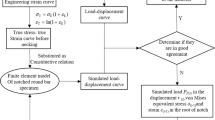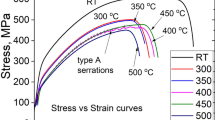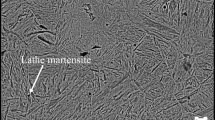Abstract
The fracture of a 316L stainless steel was investigated, both experimentally and numerically, by using two well-known ductile fracture criteria: Gurson-Tvergaard-Needleman (GTN) and Johnson-Cook (J-C). Tensile tests were modeled using the Ls-Opt of Ls-Dyna in order to determine the damage parameters of both models. The limit strains at various states of stress were further obtained by Forming Limit Diagram (FLD) experiments, and the fracture limits at different stress triaxialities were determined using the tensile test specimens with various notch sizes. Both of the used damage models predicted the fracture behavior very close to that of the experiments for the left side of the FLD. However, the prediction of the right side of the FLD by the models was found quite different from each other. The J-C damage model predicted the left side of the FLD with an error of 11.85% and the right side of the FLD with an error of 5%. The average error was 8.82% all over the FLD. On the other side, the errors for the GTN damage model were calculated 4.55 and 40% for the left and right side of the FLDs, respectively and 20% for all over the FLD curve.
















Similar content being viewed by others
References
S.P. Keeler and W.A. Backofen, Plastic Instability and Fracture in Sheet Stretched Over Rigid Punches, ASM Trans., 1963, 56, p 25–48.
F. Ozturk and D. Lee, Analysis of Forming Limits Using Ductile Fracture Criteria, J. Mater. Process. Technol., 2004, 147(3), p 397–404.
Z. Marciniak and K. Kuczynski, Limit Strains in the Processes of Stretch Forming Sheet Steel, Int. J. Mech. Sci., 1967, 9(9), p 609–620.
E. Taupin, J. Breitling, W.-T. Wu, and T. Altan, Material Fracture and Burr Formation in Blanking Results of FEM Simulations and Comparison with Experiments, J. Mater. Process. Technol., 1996, 59, p 68–78.
F. Kara, K. Aslantas, and A. Cicek, ANN and Multiple Regression Method-Based Modelling of Cutting Forces in Orthogonal Machining of AISI 316L Stainless Steel, Neural Comput. Appl., 2015, 26, p 237–250.
F. Kara, K. Aslantas, and A. Cicek, Prediction of Cutting Temperature in Orthogonal Machining of AISI 316L Using Artificial Neural Network, Appl. Soft Comput., 2016, 38, p 64–74.
I.K. Yoon, J. Jung, S.-H. Joo, T.J. Song, K.-G. Chin, M.H. Seo, S.-J. Kim, S. Lee, and H.S. Kim, Correlation Between Fracture Toughness and Stretch-Flangeability of Advanced High Strength Steels, Mater. Lett., 2016, 180, p 322–326.
N.H. Han and K. Kim, A Ductile Fracture Criterion in Sheet Metal Forming Process, J. Mater. Process. Technol., 2003, 142(1), p 231–238.
D. Zhang, Q. Shangguan, C.J. Xie, and F. Liu, A Modified Johnson-Cook Model of Dynamic Tensile Behaviors for 7075-T6 Aluminum Alloy, J. Alloys Compd., 2015, 619, p 186–194.
S. Sahu, D.P. Mondal, M.D. Goel, and M.Z. Ansari, Finite Element Analysis of AA1100 Elasto-Plastic Behavior Using Johnson-Cook Model, Mater. Today Proc., 2018, 5(2–1), p 5349–5353.
K. Limbadri, K. Toshniwal, K. Suresh, A.K. Gupta, V.V. Kutumbarao, M. Ram, M. Ravindran, G. Kalyankrishnan, and S.K. Signh, Stress Variation of Zincaloy-4 Johnson Cook Model for Rolled Sheets, Mater. Today Proc., 2018, 5(2–1), p 3793–3801.
A.L. Gurson, Continuum Theory of Ductile Rupture by Void Nucleation and Growth. Part I. Yield Criteria and Flow Rules for Porous Ductile Materials, J. Eng. Mater. Technol. Trans., 1977, 99(1), p 2–15.
M. Trillant and J. Pastor, Limit Analysis and Gurson’s Model, Eur. J. Mech. A Solids, 2005, 24(5), p 800–819.
V. Tvergaard and A. Needleman, Analysis of the Cup-Cone Fracture in a Round Tensile Bar, Acta Metall., 1984, 32(1), p 157–169.
L. Ying and D. Wang, On the Numerical Implementation of a Shear Modified GTN Damage Model and Its Application to Small Punch Test, Int. J. Mater. Form., 2018, 11(4), p 527–539.
K. Nahshon and J.W. Hutchinson, Modification of the Gurson Model for Shear Failure, Eur. J. Mech. A Solids, 2008, 27(1), p 1–17.
Y. Bao and T. Wierzbicki, On Fracture Locus in the Equivalent Strain and Stress Triaxiality Space, Int. J. Mech. Sci., 2004, 46(1), p 81–98.
G.R. Johnson and W.H. Cook, Fracture Characteristics of Three Metals Subjected to Various Strains, Strain Rates, Temp. Press. Eng. Fract. Mech., 1985, 21(1), p 31–48.
J.R. Rice and D.M. Tracey, On the Ductile Enlargement of Micro-voids in Triaxial Stress Fields, J. Mech. Phys. Solid., 1969, 17, p 201–217.
J.W. Hancock and A.C. Mackenzie, On the Mechanisms of Ductile Failure in High Strength Steels Subjected to Multi-axial Stress-States, J. Mech. Phys. Solid., 1976, 24, p 147–160.
J. Peng, Y. Wang, Q. Dai, X.D. Liu, L. Liu, and Z.H. Zhang, Effect of Stress Triaxiality on Plastic Damage Evolution and Failure Mode for 316L Notched Specimen, Metals, 2019, 9, p 1067.
Z. Li, Y.J. Zhou, and S.X. Wang, Influence of Strain and Stress Triaxiality on the Fracture Behavior of GB 35CrMo Steel During Hot Tensile Testing, Ann. Mater. Sci. Eng., 2018, 2018, p 512–524.
M. Giglio, A. Manes, and F. Vigano, Ductile Fracture Locus of Ti-6Al-4V Titanium Alloy, Int. J. Mech. Sci., 2012, 54, p 121–135.
R. Bobbili and V. Madhu, Effect of Strain Rate and Stress Triaxiality on Tensile Behavior of Titanium Alloy Ti-10-2-3 at Elevated Temperatures, Mater. Sci. Eng. A, 2016, 667, p 33–41.
B. Kondori and A.A. Benzerga, Effect of Stress Triaxiality on the Flow and Fracture of Mg Alloy AZ31, Metall. Mater. Trans. A, 2014, 45, p 3292–3307.
Y.C. Lin, X.-H. Zhu, W.-Y. Dong, H. Yang, Y.-W. Xiao, and N. Kotkunde, Effects of Deformation Parameters and Stress Triaxiality on the Fracture Behaviors and Microstructural Evolution of an Al-Zn-Mg-Cu Alloy, J. Alloys Compd., 2020, 832, 154988.
D. Anderson, S. Winkler, A. Bardelcik, and M.J. Worswick, Influence of Stress Triaxiality and Strain Rate on the Failure Behavior of a Dual-Phase DP780 Steel, Mater. Des., 2014, 60, p 198–207.
W. Bleck, Z. Deng, K. Papamantellos, and C.O. Gusek, A Comparative Study of the Forming-Limit Diagram Models for Sheet Steels, J. Mater. Process. Technol., 1998, 83(1–3), p 223–230.
K.S. Ragavan, A Simple Technique to Generate In-plane Forming Limits Curves and Selected Applications, Metall. Mater. Trans. A., 1995, 26(8), p 2075–2084.
D.J. Lewison, D. Lee, An Assessment of Different Experimental Methods for Determination of Forming Limits, Proceedings of the Fourth International Conference and Workshop on Numerical Simulation of 3D Sheet Forming Processes, Numisheet’99, Besancon, France, September 13-17, 1999.
M. Doig and K. Roll, Assessment of Damage Models in Sheet Metal Forming for Industrial Applications, Key Eng. Mater., 2011, 473, p 482–489.
T. Ioannis, M. Marion, A New Way for the Adoption of Inverse Identified GTN-Parameters to Bending Processes, 13th International LS-DYNA Users Conference, Session:Constitutive Modeling, 1-14, 2014.
Z. Zhang, A Sensitivity Analysis of Material Parameters for Gurson Constitutive Model, Fatigue Fract. Eng. Mater. Struct., 1996, 19(5), p 561–570.
M. Doig and K. Roll, Towards Industrial Application of Damage Models for Sheet Metal Forming, In AIP Conference Proceedings, 2011, 1353(1), p 1541–1546.
Author information
Authors and Affiliations
Corresponding author
Additional information
Publisher's Note
Springer Nature remains neutral with regard to jurisdictional claims in published maps and institutional affiliations.
Rights and permissions
Springer Nature or its licensor holds exclusive rights to this article under a publishing agreement with the author(s) or other rightsholder(s); author self-archiving of the accepted manuscript version of this article is solely governed by the terms of such publishing agreement and applicable law.
About this article
Cite this article
Tamer, Y., Toros, S. & Ozturk, F. Numerical and Experimental Comparison of Fractural Characteristics of 316L Stainless Steel. J. of Materi Eng and Perform 32, 1103–1118 (2023). https://doi.org/10.1007/s11665-022-07152-1
Received:
Revised:
Accepted:
Published:
Issue Date:
DOI: https://doi.org/10.1007/s11665-022-07152-1




